By any measure, a national park in Ghana that generates 946.5 million cedis (which would be around $US 100,000) per annum, is a good news story (Kakum National Park bagged C946.5m in 2003; Ghanaweb, 1 March 2005). What?s even better is that amount is reported to be over and above a 42-50 percent share of gate proceeds already paid out to the government. In other words, if you factored in the government?s share, at say 50 per cent, total revenue for 2003 was 1.419 billion cedis (more than $US157,000). I am not sure why the exact share paid to government is not specified in the story but ignore that for a moment. This good news story however begins to turn a bit sour when you consider the current patronage and revenue of the Kakum National Park (KNP) against its potential.
In terms of patronage, figures released by the Ghana Heritage Conservation Trust (GHCT) in the article suggest a 23 percent drop in patronage in 2003 compared to the previous year. It would be interesting to see figures for previous years to find out whether this is a continuing trend. As someone who visited the KNP in December 2002, I am not entirely surprised at the drop in tourist numbers. A key feature of tourism is multiple visits by visitors and a good word of mouth to bring new people to sites. That doesn?t seem to be happening with the KNP. So to understand why the number of visitors has dropped, and could drop again in subsequent years, you have to understand the current set-up of the park.
Despite its fame, Kakum has only one major attraction ? the canopy walk, a frighteningly surreal experience of walking on a bridge hung in the air above deep valleys filled with old growth forests and held together by ropes. While it is one of a few in the world with the height and attractive natural vegetation and wild animals, the canopy walk by itself is inadequate as a pull factor for overseas visitors. As a first time tourist in 2002, I was unprepared for what I saw. Many are those who get so scared they are unable to brave the canopy walk. It is that scary especially when there is a bit of wind. That is a virtue by itself so nothing wrong with that but here is the issue. If someone is unable to do the walk, for whatever reason, guess what alternate activities there are at Kakum to justify the cost of the trip and gate fees? Absolutely nothing! Nothing that would get anyone excited about making the trip to this park.
The only alternative to doing the canopy walk is a hike through the forest with a park guide pointing out trees and reading out botanical names. That may be useful for secondary school students and curious overseas visitors but provides absolutely no thrill for the general local tourist who may be looking for something unique or the overseas visitor who may be keen on seeing wild animals in their natural habitat. Whiles there are many wild animals in Kakum, we were told they have adapted to the human intrusions into their habitat by going down into the valleys during the day and coming back up late at night. That?s animal instincts for survival at work. No efforts have been made at Kakum to provide visitors some avenues for to have a glimpse of the variety of animals at the site. No look-out spots and trails to observe animals in their natural habitats. Only a few daring foreign visitors who grease the palms of park officials are allowed to camp at night and to go trekking by themselves to look for and photograph the animals. As such, a whole revenue stream is left unexplored at Kakum.
Even if you disregard the lack of alternate activities at Kakum, you simply cannot ignore the woeful lack of facilities to make a visitor feel welcome. A place like Kakum should be able to attract visitors who do not necessarily want to chase animals or release adrenalin by hanging insanely high in the air on some rope bridge. It is one of those places where you could sit and gaze far out into the trees, with or without binoculars, and enjoy the naturally beautiful scenery. People could get away from the hassle of the cities and go for a drive just to enjoy the scenery and appreciate what the nation has to offer. The need for alternate activities at Kakum is particularly urgent given the fact that the canopy walk takes no more than 30 minutes including the hike up those steep slopes. If you travel 3 hours to get to a place of interest, you need to be occupied for more than half an hour surely. In our case, we were heading to the Cape Coast Castle ? that is another story in itself ? so we didn?t have much time to waste anyway.
When you go to Kakum, not only do you have to worry about everything else but you also have to carry your lunch with you if you want a decent meal at affordable prices. What passes for a restaurant at Kakum is not fit for a village ?chop-bar? and the prices are so prohibitive only foreigners and ?buggers? tend to patronise it. For the two hours we were there, it appeared that the ten busloads of local visitors who arrived in that period had all brought their picnic along. We were hard pressed to find decent spots to sit so people were spread around the main entrance and the small grass area which seemed to have been reserved for just that purpose. The less said about the bar, the better. On our visit, the bar didn?t even have the most common varieties of soft drinks even though they were twice the street price.
At the end of our trip, and still feeling the exhilaration of the canopy walk, I walked into the souvenir shop to buy some postcards to send to my friends and work mates abroad. The few cards I found at the shop were defaced and must have been on the shelves for 10 years, at least. How do I know? Well, even the main attraction ? the canopy walk ? was not featured on any of the postcards at the so-called souvenir shop as it is a relatively recent addition to the park. No one has thought it necessary to stock the shop with useful souvenirs to generate revenue for the park. Figure that one out for yourselves! The only thing that had any semblance to the canopy walk was a hand-drawn plan of the original design which had been photocopied was being sold. I wouldn?t think any had been sold by then. You are sure to find better postcards of Kakum at the General Post Office in Accra or Kumasi. Don?t laugh because this is symbolic of how we have managed tourism over the years and yet the government still talks about visions of turning Ghana into the destination of choice for tourists coming to Africa.
Officials at Kakum claim the canopy walk has been designed to take 8 tonnes of weight but are still cautious enough to pace movement on the bridge. That is very laudable and our guide was quite good at ensuring weight was evenly distributed along the bridge. But one key question still haunts me: what contingency plans have been made to deal with any potential future mishap? There are too many stories from around the world to convince even the eternal optimists that it is only a matter of time before an accident of some sort eventuates. On our visit in 2002, there were no visible phones, safety harnesses or other emergency equipment to suggest the KNP would be able to deal with any contingency. Many of our people may not even think of such things or see that as an issue but if our intention is to attract overseas visitors and their hard-earned foreign currencies, this is an issue that needs to be addressed and quick smart.
All the above issues appear to work against the KNP because people who visit the park have few reasons to return. In addition, people are not as enthusiastic to recommend the place to others as a must see destination. I have no qualms about recommending Kakum to my fellow Ghanaians, with all the caveats, of course. However, I am not too keen to recommend the place to foreigners.
The revenue story at Kakum is by no means better. Remember that only an increase in entry fees ensured an increase in gate proceeds in 2003. A quick check of the KNP revenue released by the Ghana Heritage Conservation Trust shows the average gate fee paid in 2003 was only about 24,000 cedis, if the government?s share of revenue is factored in at a more generous 50 per cent. That is suspiciously close to the average amount paid by local tourists if you assume an equal ratio of adults, students and children at the park and also assume there were no overseas tourists. Of course, having observed that about a quarter of visitors on the day of our visit were Caucasians, including close to a 100 bare-chested white men huddled together in a cattle truck, that assumption does not hold water.
I am suspicious because the gate fees in 2003 were given as follows: local tourists 45,000 for adults, 15,000 for students and 10,000 for children giving an average of 23,300 cedis. For foreign visitors, the fees were 90,000 for adults, 45,000 for students and 30,000 for children, an average of 55,000 cedis. Just do a simple exercise with me; arrange the fees in descending order [90,000 ? 10,000] and number them 1 to 6 and consider them as ratios. You could say, for example that in an average crowd of KNP tourists there were 1 adult foreigner, 2 foreign students, 3 local adults, 4 foreign children, 5 local students and 6 local children. This would imply that at any point in time, there were 6 times as many people paying 10,000 cedis as there were people paying 90,000 cedis. If you use that ratio with the figures provided by the GHCT, the average gate fee for 2003 would be 27,000 cedis, not 24,000 as indicated. But of course, we all know that more local adults and students visit Kakum and other sites than our little exercise would suggest. So perhaps it is more likely there would have been 6 times more local adults than foreign adults, for example. That means we should expect that the average gate takings would have been much higher than that indicated by the GHCT.
Critical questions need to be asked of the GHCT and the Minister for Tourism. As far as I know, no breakdown of visitor numbers is currently available. Just imagine that we are not even told the exact portion of revenue paid to government; instead we are given a range between 42 and 50 per cent. Just imagine that. I can only assume there is something fishy happening at the KNP. Of course I stand to be corrected. Until then, however, I have to give more credence to the stories I heard from some local taxi drivers who implored visitors to the park on that fateful day in December 2002 to write about what they claim are ongoing financial ?gymnastics? at the KNP.
It doesn?t take a lot to conclude that the Kakum story is symbolic of everything that is wrong with Ghana tourism including the management and operation of the industry. If Kakum is a prime example of our efforts at encouraging tourism, we really are in deep trouble. The KNP story exposes the naivety of government and tourism officials who think that Ghana will automatically have a booming industry without too much creative effort. Our government and tourism officials should have it drummed endlessly into their heads that the natural beauty of our tourist attractions alone would not be enough to attract tourists. It takes a lot more than stunningly beautiful and wonderful natural and historical sites to become a tourist nation. We need foresight and creativity of thought as much as the investment dollars to be able to reach our stated goals.
This government, its minister, and tourism officials have made a lot of political noise about a vision to earn up to US$1.5 billion from tourism each year and generate close to 300,000 jobs, by 2007. There is no reason why that cannot be achieved. In fact, the KNP can and should be earning in excess of $500,000 a year and so should the Cape-Coast Castle, to name a few. That would only happen if we use some creativity and apply financial honesty. The government should be reminded that it doesn?t take much to develop visions. It is what follows the vision that matter: turning the vision into goals and plans, turning plans into action and getting stakeholders to come on board. Immediate and radical reforms are needed for to hold on to what little patronage we have at the moment not to talk about attracting even more visitors. It is the political gumption and will to effect changes in the sector that would determine whether the vision lives or dies. For now, there is barely a flicker! In 2005, and with barely two years before 2007 shows its face, I can say without any shadow of a doubt that we have barely scratched the surface.















